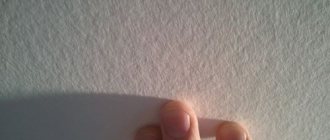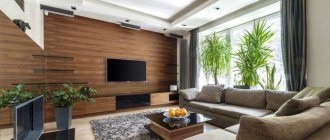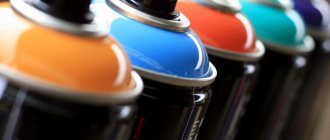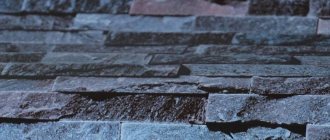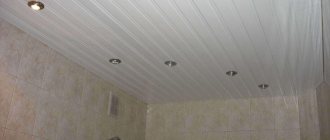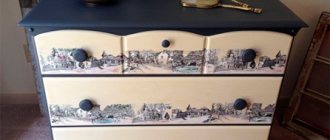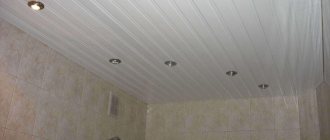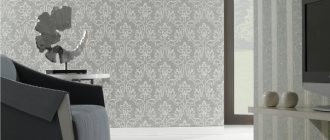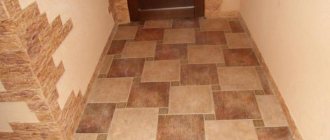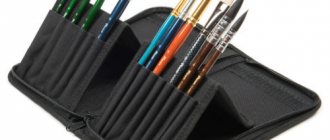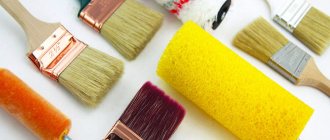“Wellton”: they decorate the unheated loggia from floor to ceiling
In the process of apartment renovation, various types of finishing are used, the choice of which is limited only by the imagination of the owners, as well as the cost of materials. An interesting solution would be to stick ceiling glass wallpaper on the surface above your head, which I make from natural raw materials.
Choice
This finishing material has many advantages, but, unfortunately, not all consumers are satisfied with the result. If the glass wallpaper is really high quality, then you won’t have to deal with a short service life and unsatisfactory appearance. The main thing is to purchase quality material.
Low-quality wallpaper can be easily identified when it is rolled up - when unfolded
small pieces begin to break off and cracks appear
Fiberglass wallpaper should be chosen not only based on its appearance. Although there are surprises here too - for example, the fibers can fluff up, and the design will begin to appear in relief. When gluing, the material is smoothed out and the effect disappears. It also happens that the wallpaper is impregnated with starch, due to this the canvas becomes denser, but the additive dissolves in the glue, and a flat texture is obtained. To check the quality of the product, you should take a piece of canvas, stick it on the wall and smooth it out.
Low-quality wallpaper can be easily identified when it is rolled up - when unrolled, small pieces begin to break off and cracks appear. You should definitely refuse such a purchase. Quality materials are always guaranteed.
You can immediately give preference to well-known brands that have proven themselves well, although their products are more expensive. Customer reviews on the Internet will help you choose glass wallpaper for the ceiling. A large number of negative impressions should alert you. To be fair, it should be noted: even good quality wallpaper can be ruined if it is not glued correctly - for example, if the surface is not properly prepared.
For gluing, a strong, even and smooth base is required, so you should not rely on the fact that glass wallpaper is a rigid material. They are glued only to a flat ceiling. In general, covering the ceiling with fiberglass is a fairly simple job.
First, they determine the places where the plaster is falling off - it needs to be removed so that later it does not fall behind along with the wallpaper. If lime crumbles, it definitely needs to be removed. This can be easily determined - run your hand over the surface and a white mark will be visible on it. To remove the lime layer, wash the surface with a wet cloth. Soot from the ceiling is also removed - this is fat that will interfere with adhesion.
For gluing, a strong, even and smooth base is required, so you should not rely on
that glass wallpaper is a rigid material. Glue them only on a flat ceiling
All irregularities are corrected with putty and allowed to dry. To be completely confident in the strength of the base, it is better to putty the ceiling completely. The surface must be primed before this.
Before gluing the glass wallpaper to the ceiling, the base is primed again. Any primer intended for finishing work is suitable for this; it is applied with a paint roller or a paint roller made of wool or foam rubber. After this, the ceiling should dry well - only in this case the base will be strong. If you are going to glue glass wallpaper onto foam plastic or drywall, the screws and seams are also puttied, and the entire surface is covered with a primer. How to prepare the ceiling for wallpapering is shown in the video on the website.
Performance characteristics
The production of glass wallpaper is labor intensive. But it's worth it. The result is a finishing material that is environmentally friendly, non-allergenic and very durable, which is ideal for finishing interior spaces, including residential premises. Fiberglass wallpaper combines both the properties of fabric and glass. On the one hand, they are soft, allow air to pass through, which helps maintain a favorable microclimate in the room, on the other hand, they do not scratch and are resistant to abrasion. When glued, the fiberglass fabric does not stretch and does not change its performance characteristics due to changes in temperature and humidity levels. Another argument in favor of glass wallpaper is its non-flammability. The surfaces are covered with glass wallpaper to prevent the spread of fire. In addition, glass wallpaper has high antistatic properties: dust practically does not settle on its surface. They are not susceptible to infection by fungus and mold, because... they lack the necessary nutrients for the development of these organisms.
35 years is the average service life of glass wallpaper. In general, the service life and preservation of the quality characteristics of the material depend, first of all, on the quality of the paint and glue, as well as on the frequency of washing.
Ceiling pasting
There are several recommendations regarding how to glue glass wallpaper to the ceiling. First of all, the temperature in the room should be 18-25 degrees, and the relative humidity should be up to 70%. After completion of work, the room should be protected from drafts and sunlight.
Before gluing, the wallpaper is cut to the required length. This is done with a special painting knife, usually a ruler or level. For the first sheet, it is recommended to draw an approximate line using a pencil. Then glue is poured into the paint tray, and you can start working.
There are several recommendations regarding how to glue glass wallpaper to the ceiling.
First of all, the temperature in the room should be 18-25 degrees
The glue is applied with a paint roller across the entire width of the sheet, leaving a small margin so that drops do not fall on the floor. The canvas is applied to the surface and smoothed with a plastic wallpaper spatula. It is better not to press down the edges too much, so that it is convenient to glue the adjacent strip, since they need to be joined closely.
The next sheet is glued joint to joint, while watching how the fibers are intertwined at the edge. In order for the junction to be almost invisible, the pattern must match. If the canvases are lying incorrectly, the last of them can be gently moved to the side with tightly pressed palms.
If the edge of a sheet of wallpaper is torn, the next sheet is glued overlapping rather than joined. Of course, this place will begin to bulge, so a paint knife is drawn along the joint and the excess is removed from each sheet. After this, the overlap will be invisible. You can watch the video to understand how to glue glass wallpaper to the ceiling.
Fiberglass for plasterboard surfaces: advantages and rules for gluing
Experts recommend that before work, you take into account the source of natural and artificial lighting in order to make the right decision regarding the choice of method for gluing wallpaper on the wall. Fiberglass begins to stick only after the wall has completely dried. To correctly determine the amount of material, before starting all work, the wall is measured; for this, the length from floor to ceiling is taken and multiplied by the number of walls.
There is no need to subtract the openings! In order to glue fiberglass to a plasterboard surface, you can use wallpaper glue, but it is best to buy compounds designed specifically for glass wallpaper. Why is this so? The fact is that many dry mixtures contain starch, and it does not hold glass wallpaper very well, so you should choose a mixture in such a way that it contains PVA, but in a diluted state.
Using a brush or roller, the prepared adhesive composition is applied to the back surface of the material, after which the glass wallpaper is glued to the drywall. Fiberglass is usually glued in such a way that the joints are not visible. To do this, approximately 2-3 mm of gap is left between the individual strips, which is then puttied and cleaned. After this, the glass wallpaper is covered with a layer of paint and all joints become simply invisible. But in side light, ugly dark stripes with a width of up to 5-10 cm are visible.
This is due to the fact that when sanding, sandpaper fluffs up the fiberglass layer, disrupting its structure; such a strip does not reflect light. The only disadvantage of glass wallpaper is its high cost. But if you look at their advantages, you can fork out some money.
After all, they will last much longer, which in itself justifies the costs.
- gluing can begin only after the primer has completely dried;
- prepare the adhesive solution according to the instructions given on the package;
In a similar sequence, the entire surface of the ceiling is sealed, cutting off the excess length of the material. The final step is to apply glue on top of the web. After the canvases have completely dried, which occurs after 24 hours, you will receive a reliable reinforcing layer that will allow you to forget about repairs for a long time. To create a relief pattern on ceilings and walls, it is not necessary to purchase expensive wallpaper.
It is enough to cover the surfaces with fiberglass, which can serve as an effective strength barrier. It is fixed with a special glue, after which it is primed, covered with putty and painted. Thanks to the reinforcing properties of the material, the service life of the coating, which is subject to numerous repaintings, is significantly extended.
How to treat the surface → Room decoration → How to choose the right paint → Surface treatment technologies → Leveling and finishing the walls → Selecting and applying a primer → Removal from the surface → Stretch ceilings and technologies → Reviews and testimonials
Painting glass wallpaper
After gluing, this material can be painted in any color, based on personal preferences and the interior of the room. The paint is applied with a structural roller when you need to get a monochromatic coating. If you want small small veins to remain, dense foam rubber will do. It is better to use a brush at the joints. It is recommended to use water-dispersion paint based on styrene-butadiene or acrylic binders. It is easy to apply, dries quickly and has almost no odor.
Painting is done in two layers, each of which must dry for at least 12 hours. If you apply a lot of paint, the glass wallpaper may lag behind the surface - the best option is to use 500-600 grams per square meter. Thicker wallpaper will require more paint. The photo shows examples of painted glass wallpaper.
Glass wallpaper for painting on the ceiling will definitely please those who value not only the external beauty of the finish, but also durability and practicality. The main thing is to choose high-quality material and use it correctly, and then the result will delight you for many years.
What are glass wallpapers made from?
The raw material for the production of glass wallpaper - fiberglass yarn - is obtained from glass melted at a temperature of 1200 0C from rocks such as limestone, quartz sand and dolomite. The molten glass is then drawn into thin translucent fibers.
In addition to fiberglass wallpaper, fiberglass is used to make fiberglass (or web), which is widely used as a reinforcing material. Fiberglass makes the surface smooth and velvety. To obtain fiberglass, fibers are pressed using the wet paper method. Fiberglass wallpaper, unlike canvas, is spun on special equipment reminiscent of a traditional loom. Fiberglass yarn is used to produce threads from which the wallpaper itself is subsequently created. To stabilize the material, the woven fiberglass fabric is impregnated with a special starch-based composition. Glass fiber wallpaper is considered to be of higher quality the denser the threads, the higher the frequency of fibers, and the less starch in the stabilizing impregnation.
Preparation of canvases
It begins when the walls are already dry. Only then can you begin to cut the roll of glass wallpaper into separate parts in height, while leaving an allowance (up to 10 cm) so that the pattern can be correctly aligned.
In this case, the air temperature in the room should be at least 18 degrees, and the humidity should be up to 70%. These factors affect the quality of work, so it is important to prepare the space in a timely manner. Do not forget that gluing glass wallpaper is a special job that is not carried out when there are drafts, so they need to be eliminated.
Gallery
Covering walls with glass wallpaper for painting
Smooth fiberglass wallpaper for painting
Wellton fiberglass wallpaper for painting
Fiberglass (glass wallpaper) “spider web” for painting
Advantages of the material
In addition to the fact that fiberglass coatings can be repainted up to thirty times without losing their beautiful appearance, this design option has other serious advantages over covering the ceiling with traditional wallpaper or conventional painting of the surface.
- The coating is very strong and durable.
- The width and length of a roll of such wallpaper is twice as large as that of standard options - this will allow for faster finishing.
- The fiberglass from which the coating is made does not support combustion.
- Fiberglass does not cause allergies, as it is made from non-toxic natural materials.
- Working with fiberglass is easy and even someone who has no experience in such matters can figure out how to glue such wallpaper on the ceiling.
- The cost of finishing will be low.
- The color of the coating is determined at will and can be absolutely anything.
With so many positive qualities, this type of design has no significant disadvantages. There is only one insignificant drawback - the not very large range of textures offered. However, for each room you can find a suitable option even using a limited number of textures.
����, ������������, ��� ������ ����������:
1. ������� ����������� �������� ��������� � ����� ������, ������� ������������� ������� �� ���������� ������� ������ ����� ������.
2. ���������� �������� ��������� �����. ��� ��������� ������ ����� ����� �� ������������ �� ������ �����������, ������������ � ����������� ����� ������������� �������, ������ �� ��������� � ������ ���� ����� ���.
����� �����������3. ��� ����� ����������� ���������� ������������ ����������, ����� ���������� ������� ������ ��� ������� �� ������ � ������.
4. �������� ���������� ������ ����� ������� ���������� ������������� ����.
5. ������ �������� �� ����.
6. ������� �������� �������� ����. ��� ����� �� ���� ��������� ����������, ������ ������ �����, � � ������� ������ (���������� �����, ������������� �� �����) ��� ������������� ������ ��� ����� 90� �������� ������������ �����.
��������� ��������
7. ������� �������� ������������� �� ����������, � ������ �����. �������� ��� ������� �������� ������� ��� ������� ������.
���� ������� ������������ �� ����������� �������� ��������
�����! ��� ��� ��� ��������� ���������� ������������ � ����� ������, ������ ����� ������� ����� ������. �� ��������� ���������� ���������, � ���� ����� ��������� �� �����.
8. ���������� ������������ ������ ����� � ������� ������� ����� ����������.
9. ����� ���� �� �������� � �����, ���������� ��������� �������� ������� ����� �������, ����� ������������ ������� ����� �������.
10.
��� ��� ����� ������� �� ������ �������� �������, ���������� ������� ��������� ������� �� ����� � ���. � ���������� ������� ����� �������. ��� ��������� ������� ����� � ������� ������������ �������, ������ ��� ��������� � �����, � ����� ���� �������� �������� �����.
������� ������� ������� ��� �� �����
11. ����������� ���� �������� ����� ����� �� ������ ������� � �����.
12. ������� ������������ �����, � ����� ������� ����������� �������� ��� ������� �������� ���������� ����������� �������� ������� � ����� � ������ �������.������������� �����������13. ������� �������� ������� ������� ����� �������.
14. � ����� ���������� �� ��������� ������� ������� ����������� ���������. ��� ����� �� ����������� � ��������� ��������� � 1 ��, � �����, �������� �������, ����� ����� ����� ��� �������.
����� �� ����� ��������� ��� �������
15.
������ ���������� ������. ������ ��� ������� ��������� �������. ��� ���� � ������� ����������� ������ ������ �� ����� 2 �����.
������� �����������
16. ���������� �������� ������ ��������� ������. ��� �������� �� ������� � ��������� ��������� ����� ��������� �� �������� ������ ������� �����.
17. �� ��������� ��������� �������� ��������� ��� ��������� ������� ������� ������, ������ ��� �����������, � ����� �������������.
18. ��� ������� �� ����� ������������� ��������� ������� � ������� ���������� ��� ����������� �������.
������� � ������� ����������
One way to make a beautiful ceiling is to hang wallpaper. This material can have a different structure, color, pattern.
Glass wallpaper looks very nice. Pasting the ceiling with glass wallpaper decorates the interior and gives it expressiveness - you can see this by looking at the photo.
Special glass - the starting material - is heated to a temperature of 1200 degrees, after which it turns into a liquid state and then threads can be pulled out of it, which are woven into fibers, and then yarn, and made into a fabric called glass wallpaper. This material is almost impossible to set on fire at home; it is classified as highly flammable and non-flammable.
